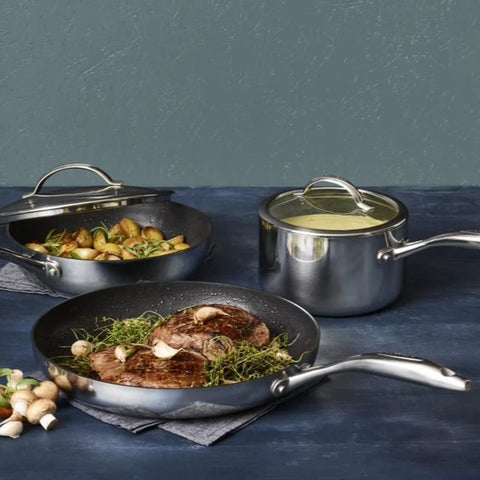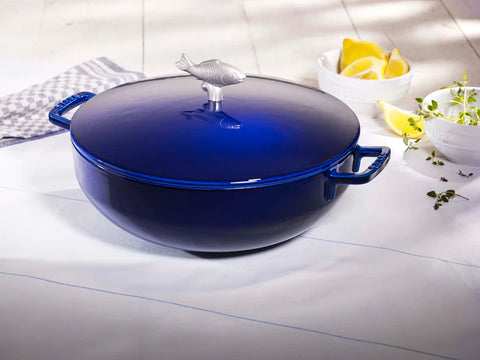
Your home should be made up of a collection of things you love – and the cookware you keep is no exception.
The right pots and pans can improve your meals, minimize clean up, and make the whole cooking experience more enjoyable for the chef. Not to mention those lucky enough to savor the food when it’s placed on the dining table!
When it’s time to stock your kitchen with new pieces, or if you’ve been considering adding to your current assortment, there are a few things to consider.
Do you need a full set or just a few individual pieces? What material is best for your needs?
How will you care for your new cookware?
And, perhaps most importantly….
What type of food do you actually like to cook?
Material, function and usability are the key ingredients to look for when choosing new cookware. Sure aesthetics play a role too, but you won’t care how pretty your new skillet is if your homemade hash browns keep sticking to the bottom whenever you turn up the heat.
The truth is, cooking can be an absolute joy when you have the right equipment – and a disaster when you don’t.
To avoid any pitfalls, we’ve pulled together this handy guide to help you select the best cookware for your needs, so you and your family can reap the benefits for years to come.
When it comes to cookware, material matters
There is a smorgasbord of cookware materials to choose from and what’s right for you will depend on the foods you enjoy to cook. Which is why it pays to be aware of the key differences and what works with specific cooking styles.
Stainless steel
Stainless steel is durable, versatile and suitable for cooking almost all food types. It’a also very easy to maintain and keep clean – in fact, some stainless steel cookware is even dishwasher safe.
What’s more, this type of cookware is fairly damage-resistant, so you won’t have to worry about scratching the coating or warping its shape. Plus, it can withstand high heat – an excellent choice if you like to sauté bell peppers or braise beef or chicken.

That being said, stainless steel is not the best heat conductor, so it’s best to look for multi-ply pieces that have aluminum wrapped around the entire vessel, like the Scanpan HAPTIQ Fry Pan. This hardworking pan heats quickly and evenly – and looks great at the same time.
Although stainless steel cookware clad with aluminum can be more costly, these pieces perform better and tend to last a lifetime, so they’re a worthwhile investment.
It’s also worth noting that some less expensive stainless steel pans only have a piece of aluminum clad at the base. In these pans, the sides of the pan will not heat evenly.
Aluminum
Aluminum is a common cookware material found in most private and commercial kitchens. You no doubt have a couple of trusty aluminum pots hiding away in your own cabinets!
Aluminum cookware is smooth and scratch resistant. It’s also extremely lightweight and conducts heat well– a terrific choice for poaching eggs. But it’s not the best material for acidic foods like tomato-based sauces or stewed plums.
But if you’re someone who enjoys cooking a hearty lamb chop or flavor-packed chicken breast on your stovetop, you can purchase aluminum grill pans that are durable, heat-insulating and fairly inexpensive.

The Ballarini Parma Plus 11-inch Aluminum Nonstick Grill Pan is a favorite amongst the Sabavi Home team.
Cast Iron

If you’re into slow cooking, cast iron might be your best pick. Tough, long-lasting and naturally non-stick, cookware like the Staub Cast Iron 5-qt Bouillabaisse Pot maintains heat longer than most metals – a great option for lovingly cooking chowders, meat braises and other one pot dishes.
This type of cookware has a more ‘traditional’ look than aluminum or stainless steel. And while it’s usually oven and dishwasher safe, cast iron is incredibly heavy! Some pieces can weigh up to 10 lbs or more. Slow to heat and cool, it’s the perfect vessel for comfort foods like stew.
Ceramic
Ceramic cookware has become increasingly popular over the past few years. Lightweight and easy to clean, it's great for browning a steak or frying an egg. Ceramic cookware can also handle acidic foods more easily than aluminum and its thick body construction allows it to withstand high heat.

We love the Zwilling Clad CFX line, which is safe to use with almost all metal utensils, heats evenly and quickly, and is dishwasher safe.
What’s cooking?
From paella pans to double boilers, woks to dutch ovens – there are a stack of different cookware types to help you sauté vegetables, brown meats or boil soups.
Before spending big on a beautiful stock pot or cast iron skillet, it’s wise to have an understanding of the different pieces available and what you might use them for.
Fry pans
Fry pans are an essential requirement for most kitchens and ideal for browning, frying, searing or sautéing. They have a round shape, slightly sloped sides and long handles for easy maneuvering.

We are particularly fond of the Scanpan Classic Plus Fry Pan. Artisan made in Denmark, this durable pan performs with or without oil and is compatible with both gas and electric stovetops.
Saucepan
A sauce pan is another kitchen staple. Featuring high sides and a sturdy base, they are perfect for creating homemade sauces, as well as simmering and boiling liquids.

If you’re looking for a high quality saucepan to add to your cookware collection, we recommend investing in the Ruffoni Symphonia Prima 1.5 Qt. Covered Saucepan.
This classic design promises long lasting performance – a piece you’ll pass down to generations to come.
Stock pot
A stock pot is one of the largest pieces of cookware you can find – so if you’re low on kitchen storage, you might need to forgo one. But if you have a large family or entertain, these versatile pots are a must-have.
Their tall height and thick base means they preserve heat well, making them the best utensil for preparing soups, seafood and vegetables.

We have a wide range of stock pots available at Sabavi Home, but we particularly like the copper-wrapped Ruffoni Symphonia Cupra 8 Qt. Covered Stockpot, which offers impeccable heat conduction.
Braiser

Featuring a shallow height and wide cooking surface, braisers like the Ruffoni Symphonia Prima 7 Qt. Covered Braiser are designed for long, slow cooking. An excellent choice if you enjoy preparing braised meats, legumes and vegetables.
Should you buy cookware as a set or individually?
This is a question almost every home cook has asked themselves - invest in a set or just buy individual pieces commonly known as open stock.
The answer is usually both! Cookware sets offer great value and provide a solid foundation to any kitchen. You’ll likely want to supplement your set with a few additional pieces, whether it’s additional sizes or special pieces like a wok, roasting pan, braiser, etc.
Before purchasing anything, it is worthwhile asking yourself:
How many people do I typically cook for?
What type of foods do I enjoy cooking?
How much can I afford to spend on cookware?

No matter what type of cook you are you may be best served by starting with a set like the Zwilling Motion Nonstick Hard-Anodized 10-Piece Cookware Set in Grey, the Henckels International Capri Series 10 Piece Non-Stick Cookware Set, or the Symphonia Prima 7 Piece Set.
A few more considerations
Upgrading your kitchen essentials is a huge investment in time and money, so it’s also a good idea to keep these points top of mind:
Stovetop compatibility – this is especially important if you have an induction stovetop. Confirm that the cookware you intend to purchase works well with your stovetop.
Aesthetics - you should like the look of your cooking vessels. While functionality is key, you also want to select cookware that appeals to you and fits in with your kitchen. Pay attention to the size, weight and handles as well. If the pieces are too bulky or uncomfortable for you to hold, you won’t enjoy them.
Care guide - we recommend hand washing your cookware so that it lasts longer. But if you want the option of putting your cookware in the dishwasher, make sure you purchase pieces that are clearly marked dishwasher safe.
Warranty – your cookware will come with a warranty which provides an indication as to how long the manufacturer expects the cookware to last.
Ready to upgrade your cookware?
Sensational! You can browse our curated collection of cookware now over here.







